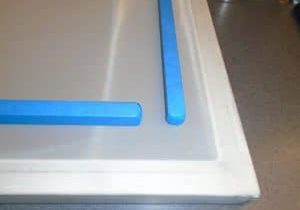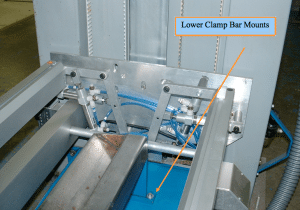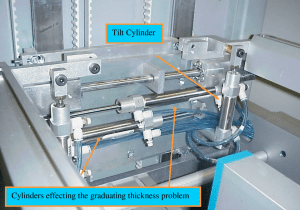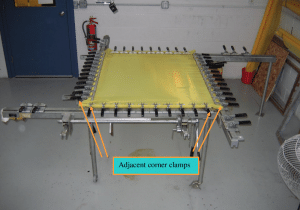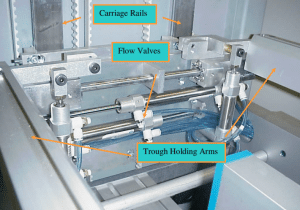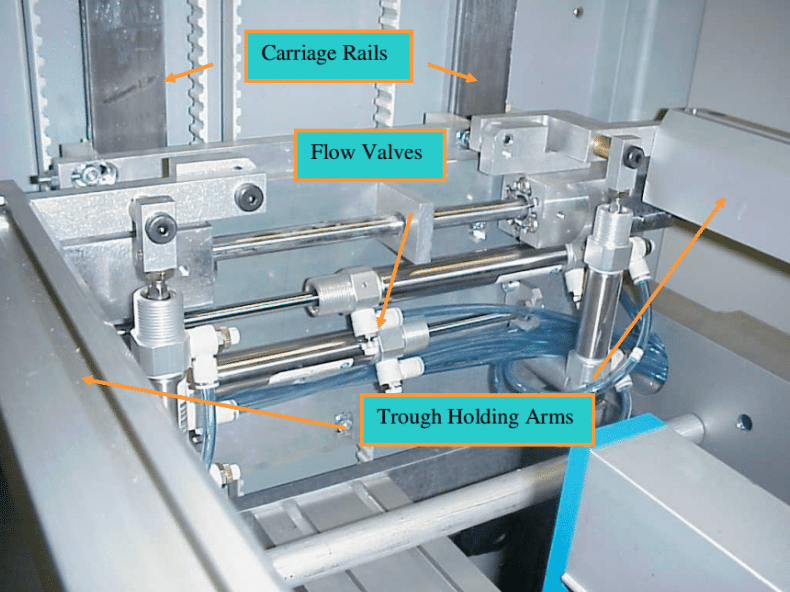
Proper maintenance of a coating machine (and troughs for that matter) is a fairly simple and not a very time-consuming task in the grand scheme of things. Obvious, but not always followed, if it’s dirty, clean it. If it moves, grease it. If it leaks air, stop the leak.
Poor edge quality (knicks)
With coating troughs, poor edge quality (knicks) will leave vertical lines up the screen and will certainly show up in the print. Over time from handling, small knicks will appear on the edges. Buffing with a product like a Scotch Brite pad found in your local supermarket can often significantly reduce the imperfections and reduce the effects on the screen. I don’t recommend any kind of sandpaper because it’s generally too coarse and will cause more problems than it solves. If the knicks are too severe to be corrected with the Scotch Brite pad, you should consider replacing them.
Dried emulsion
Dried emulsion on the coating trough edges during the coating process will also certainly cause lines or streaking. During the coating process, every screen or couple of screens, wipe the edges with a damp (not wet) cloth to remove the excess emulsion underneath the lip of the trough. Don’t use a “wet” cloth because the excess water will find it’s way into the trough/emulsion and cause a whole new set of issues.
Machine cleanliness
Quite often a spill will result in emulsion getting into the mechanics of the lower frame clamps. It is far easier to spray water on the affected parts and wipe with a rag off the base plate then it is to take the clamps apart later and clear the dried emulsion. The emulsion can also find its way onto the carriage and carriage mechanics. Emulsion on the carriage, or more specifically, the trough holding arm can cause the troughs to not sit correctly and thus affect the overall coating results. Emulsion in the carriage mechanics can cause problems with parts not moving as accurately as they should, also affecting results.
Grease moving parts
It is crucial to grease the rail that the carriage rides on. If the carriage rail has not been properly maintained (greased) the carriage will tend to “chatter” as it travels upward leaving horizontal lines in the screen every 1/4″ or so. It is not necessary to grease the entire surface of the rail, just the surfaces that comes in contact with the carriage guides.
First wipe the rails clean (WD40 works very well). Then reapply a layer of grease where the guides contact the rail. I recommend white lithium. Then use the same clean and reapply technique to the cylinder shafts of the carriage, but wipe clean with a dry rag. WD40 is not good for the cylinder seals.
On older machines that use a chain to pull the carriage, clean and grease them as well (don’t forget the drive chain inside the control cabinet). Also on the older machines that use bearings to guide the carriage instead of the Delron guides, a little lightweight oil in the bearings is a good idea. Once everything is lubricated, cycle the machine a few times to work it in.
Air leaks
Leaking air can affect the precision of the emulsion application (inconsistent pressure). Whether air is leaking from the cylinders, the flow valves on the cylinders, or the quick connect fittings anywhere on the machine, it should be addressed. Leaking air also puts an extra, unnecessary strain on the air compressor. Defective air components are relatively cheap and easy to replace.
If you have a question, please post it in the comments below. If you need immediate support, get in touch.



